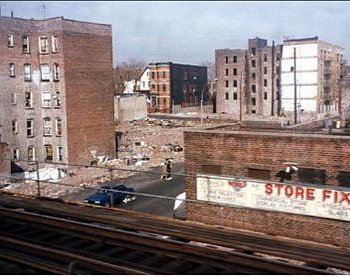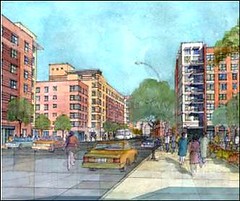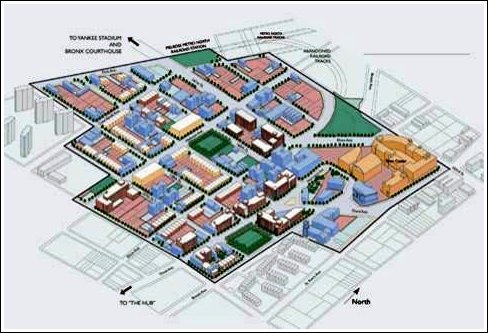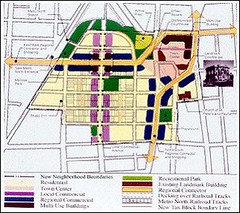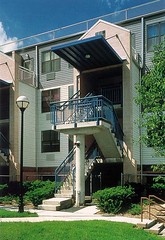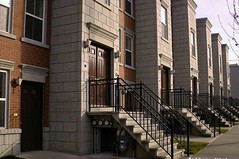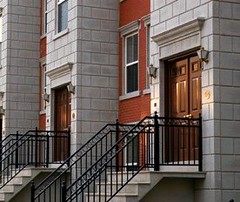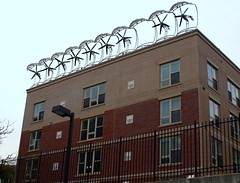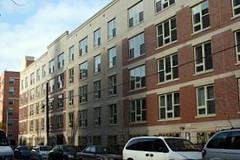Inclusive revitalization at its best: Melrose Commons in the South Bronx

Posted January 18, 2010 at 1:41PM
Today, as we remember Dr. Martin Luther King, Jr., I like to think that the great civil and human rights leader would be pleased by the way the values he lived for are represented in the story of New York City’s Melrose Commons.
Melrose is a large-scale redevelopment project that, when completed, will comprise some 2,000 mixed-income homes along with shops and services in a part of the South Bronx that had deteriorated badly. The project is making great progress and enjoys very good sustainability characteristics, along with strong support and participation from neighborhood residents working to improve their community. But, as with many such stories, it did not begin that way.
It is hard to imagine now, but the South Bronx was once farmland. It was subsequently settled by immigrants in the mid-19th century and thrived as a collection of well-functioning city neighborhoods for many decades. But beginning in the 1950s it was badly hurt by the all-too-typical urban pattern of white flight to the suburbs, highway construction that created physical barriers between districts, disinvestment, building deterioration, and then “slum clearance.” 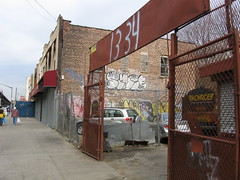 By the 1980s the South Bronx had lost two-thirds of its population and had become world-famous for urban deterioration, crime and arson. By the early 1990s its population had declined to less than 6,000 of the nation’s poorest people.
By the 1980s the South Bronx had lost two-thirds of its population and had become world-famous for urban deterioration, crime and arson. By the early 1990s its population had declined to less than 6,000 of the nation’s poorest people.
The New York City government had begun planning redevelopment of the area in the 1980s. But, when a plan was finally announced in 1990 to replace a 30-block portion of the South Bronx with a massive new development, neighborhood residents were understandably upset, not least because they felt they had not been adequately consulted and many of them would be displaced. While the residents had known a planning process had been under way, they believed that they not had a fair opportunity to review and influence the plan - which called for 2,600 new units of housing, 250,000 square feet of new commercial space, and a realignment of the street system - as it was being constructed. Some critics believed the development also was largely suburban in character, out of place for its urban setting.
According to an excellent summary posted on the web site of the Sustainable Communities Network, people in the affected community gradually began to gather together to discuss pending developments in the neighborhood. The Bronx Center project, a local community group, hosted a public meeting on the issues in 1992. Among the residents’ concerns were displacement, the affordability of the proposed new housing, the welfare of existing neighborhood businesses, 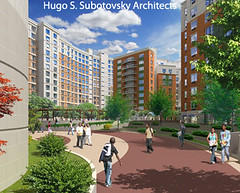 a failure to plan for services (health care, senior citizens, youth, libraries) needed in the community, the street realignment, and the overall quality of the project.
a failure to plan for services (health care, senior citizens, youth, libraries) needed in the community, the street realignment, and the overall quality of the project.
With the assistance of the Bronx Center project, the neighbors formed an organization called Nos Quedamos (“We Stay” in Spanish) that quickly brought together a diverse, inclusive group of community residents along with municipal representatives. At the request of the Bronx borough president, the community was allotted time to formulate an alternate development plan. And, to their credit, the city’s Departments of Planning and Housing and Urban Development agreed to meet with the group on a weekly basis to help formulate a new, more responsive vision. Staff members from the city’s Departments of Transportation and Environmental Protection, the Bronx borough president's office, and the mayor's office also agreed to participate.
With the help of Magnusson Architecture & Planning, Nos Quedamos began to construct an alternative development proposal that would allow the residents to stay and that would better protect their long-range interests. According to another excellent summary, prepared for the World Sustainable Building Conference in Melbourne in 2008, after only six months of meetings and charrettes the group had persuaded the city to adopt their alternative instead of the original plan.
The resulting Melrose Commons Urban Renewal Plan (bullet points here, detailed summary here) was built around an impressive set of forward-looking, inclusive sustainability features that embodied many principles of smart urbanism and green building before either became a common part of the planning vocabulary:
- No involuntary displacement of existing residents and businesses
- Varied, mixed-income ownership and rental housing
- Housing densities appropriate to an urban community
- Attractive architectural design to facilitate a welcoming neighborhood environment and attract development
- Physical development that is both environmentally conscious and sustainable
- Open space distributed in a way that responds to the community's concerns for security (the city's original plan had called for a single large, open field that neighbors felt would create security risks)
- Respect for existing street and movement patterns
- Appropriate distribution of commercial space and services that enable community residents and businesses to expand their economic opportunities
- Development that complements existing infrastructure and the community's regional location, while providing for the neighborhood’s future growth and evolution
Today Nos Quedamos, now organized as a community development corporation, is the guiding force behind the plan’s implementation. From their website:
“It is our intention to guide the process of change, progress, and implementation of the housing and urban development goals we defined in the Melrose Commons Urban Renewal Plan. Nos Quedamos views the urban renewal process as not only encompassing physical regeneration, but also addressing socio-economic and environmental conditions in the area. Our goal is to develop an economically productive, sustainable, and healthy community. This vision is one that respects, supports and involves the existing community in the formulation of plans and policies that address the issues of housing, open space, community renewal and its sustainability.”
In other words, the community is in charge of its own regeneration and is an equal partner with the city in making it happen.
A range of private developers and architects are involved in building out the plan, and many are incorporating impressive green features. For example, the townhomes pictured in the photos just above, designed by David Danois Architects and environmental consultant Steven Winter Associates, received the top residential award from the Northeast Sustainable Energy Association in 2003. They include a variety of high-efficiency appliances as well as interior finishes that are low in evaporative pollution. New homeowners have been given manuals that explain green maintenance procedures and energy-saving features.
Writing last month in the Mott Haven Herald, Jeanmarie Evelly reports that the Eltona, a multifamily building that features rooftop windmills, pictured below, has recently received a LEED platinum rating for its environmental features. Moreover, its residents will be participating in a study by the Mount Sinai School of Medicine to assess the health effects of living in a green building. Researchers hope, among other things, that the building’s ban on smoking will reduce asthma symptoms in a neighborhood where asthma has been epidemic.
Eltona residents will also be eligible, Evelly writes, to receive on-site job training from Wildcat Service Corporation, a workforce development organization. The building houses 63 apartments subsidized to be affordable to families making 60 percent or less of the region’s mean income. In addition to the Eltona, Evelly’s article cites three other Melrose buildings that have received or are on track to receive green certification.
Nos Quedamos’s web site has an environmental section that reports on its advocacy for brownfield remediation and redevelopment, air quality improvement and, of course, green buildings:
“Nos Quedamos continues to push for green and LEED (The Leadership in Energy and Environmental Design Green Building Rating System™) certified developments, encompassing materials, systems, and high efficiency Energy Star® appliances and fixtures which help reduce energy and water usage in our projects; urban agriculture, roof gardens, including green spaces with native plants as well as capturing and reusing rain and gray water. All these measures allow our buildings to create a positive impact both for the environment and the community.”
The greenest features of Melrose Commons, however, will be its location, transportation connections, walkability, and urban design. These will reduce the per capita environmental footprint of the project’s residents, businesses, and visitors immensely.
Nos Quedamos has entered Melrose into the LEED-ND pilot program, and I hope it scores well. For all sorts of reasons, it’s one of my favorites.
